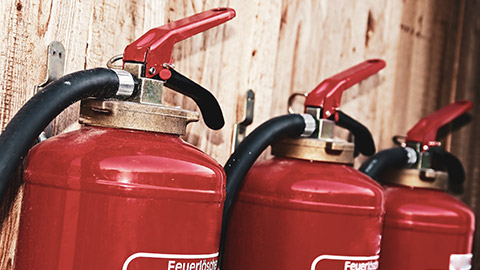The NCC Section C through to H details the requirements to ensure a level of fire safety is achieved within new construction. These sections are as follows:
- Section C: Fire resistance
- Section D: Access and egress
- Section E: Services and equipment
- Section G: Auxiliary provisions
- Section H: Special use buildings.
These sections all relate and work together to ensure in the event of a fire there is a level of safety and integrity to the construction to assist in saving lives.
The Australian Building Codes Board developed a fire safety presentation, which can be accessed here, this presentation goes into greater depth in relation to how these sections work towards fire safety in new construction.
Before discussing fire safety systems requirements, you must be able to determine the different classes of fire first. This will help you understand the hazards involved and identify the measures and equipment you must use to contain each class of fire.
Fires are classified according to the materials that fuel them. These are specified in the Australian Standard AS/NZS 1850:2009 portable fire extinguishers, Classification, rating and performance testing.
A summary of fire classifications and their descriptions can be found below:
Class A
- Involves carbonaceous solids (contains the chemical element carbon as the basic fuel) such as wood, paper, cloth, plastic, grass, coal or rubber
Class B
- Involves flammable liquids such as petrol, turpentine, kerosene, tar, paint or wax
Class C
- Involves flammable gases such as hydrogen, butane or methane
Class D
- Involves combustible metals such as sodium, magnesium, potassium or aluminium shavings
Electrical
- Involves materials in Class A and B fires but with introduction of electrical equipment such as wiring, electrical appliances and other electrically energised objects in the vicinity of the fire.
- Once the electrical equipment is removed from the fire, the classification of the fire changes.
- Officially there is no Class E fire because electricity is not a fuel. However, it is a source of heat and potential source of electrical shock to a fire.
Class F
- Involves cooking fats and oils.
- The temperature of the oils that are on fire is higher than that of flammable liquids. Hence, normal extinguishing methods are ineffective.
Fire safety systems refer to the means and equipment to detect, inform, intervene, or evacuate a building when there is a fire. They typically perform one or a combination of the following functions:
- Warn occupants when there is an emergency.
- Ensure that the conditions for evacuation are safe.
- Restrict the spread of fire to other parts of the building or adjoining buildings.
- Suppress fire.
This short video will explain the different parts or elements, of fire protection systems and how they are designed to protect people and property:
At the end of the module, in the Summary, you can read about fire protection systems explained in the above video.
The NCC contains Fire Resistance Levels (FRL) requirements for elements used in Type C Fire-Resisting Construction, and it states that a building:
| No. | Checks |
|---|---|
| 1 | a building element listed in Table 5 (NCC Vol 1) and any beam or column incorporated in it, must have an FRL not less than that listed in the Table for the particular Class of building concerned; and |
| 2 | an external wall that is required by Table 5 to have an FRL need only be tested from the outside to satisfy the requirement; and |
| 3 | a fire wall or an internal wall bounding a sole-occupancy unit or separating adjoining units must comply with Specification C1.8 (NCC Vol 1) if it is of lightweight construction and is required to have an FRL; and |
| 4 | in a Class 2 or 3 building, an internal wall which is required by Table 5 to have an FRL must extend—
|
| 5 | in a Class 2 or 3 building, except where within the one sole--occupancy unit, or a Class 9a health-care building, or a Class 9b building, a floor separating storeys, or above a space for the accommodation of motor vehicles or used for storage or any other ancillary purpose, and any column supporting the floor, must—
|
| 6 | in a Class 9c building a floor above a space for the accommodation of motor vehicles or used for storage or any other ancillary purpose, and any column supporting the floor, must—
|

As mentioned earlier, passive fire protection measures typically refer to the components and materials that help maintain the structural fire protection of a building. The table below summarises the NCC requirements of passive fire protection elements and the respective Australian Standards.
| Passive Fire Protection | NCC Requirements | Relevant Australian Standards |
|---|---|---|
| Fire-resisting building elements |
|
|
| Non-combustible building elements |
In a type B construction, the following elements must be non-combustible:
Examples of non-combustible materials, according to NCC are:
|
|
| Fire doors |
|
|
| Fire windows |
|
|
| Fire shutters |
|
|
|
Smoke doors |
|
|
| Proscenium walls (fire curtains) |
|
On the other hand, active fire protection uses firefighting techniques and equipment to fight the source of a fire and extinguish it. The table below shows active fire protection elements with their respective NCC requirements and Australian Standards.
| Active Fire Protection | NCC Requirements | Relevant Australian Standards |
|---|---|---|
|
Smoke and heat alarm systems |
|
|
|
Smoke and Heat Detection Systems |
|
|
|
Fire hose reel systems |
|
|
|
Portable fire extinguishers |
|
|
|
Fire hydrants |
|
|
|
Emergency warning and intercom systems |
|
|
|
Building occupant warning system |
|
|
|
Emergency escape lighting and signs |
|
|
|
Automatic fire sprinkler systems |
|
|
|
Smoke and heat vents |
Must have the following components:
|
|

